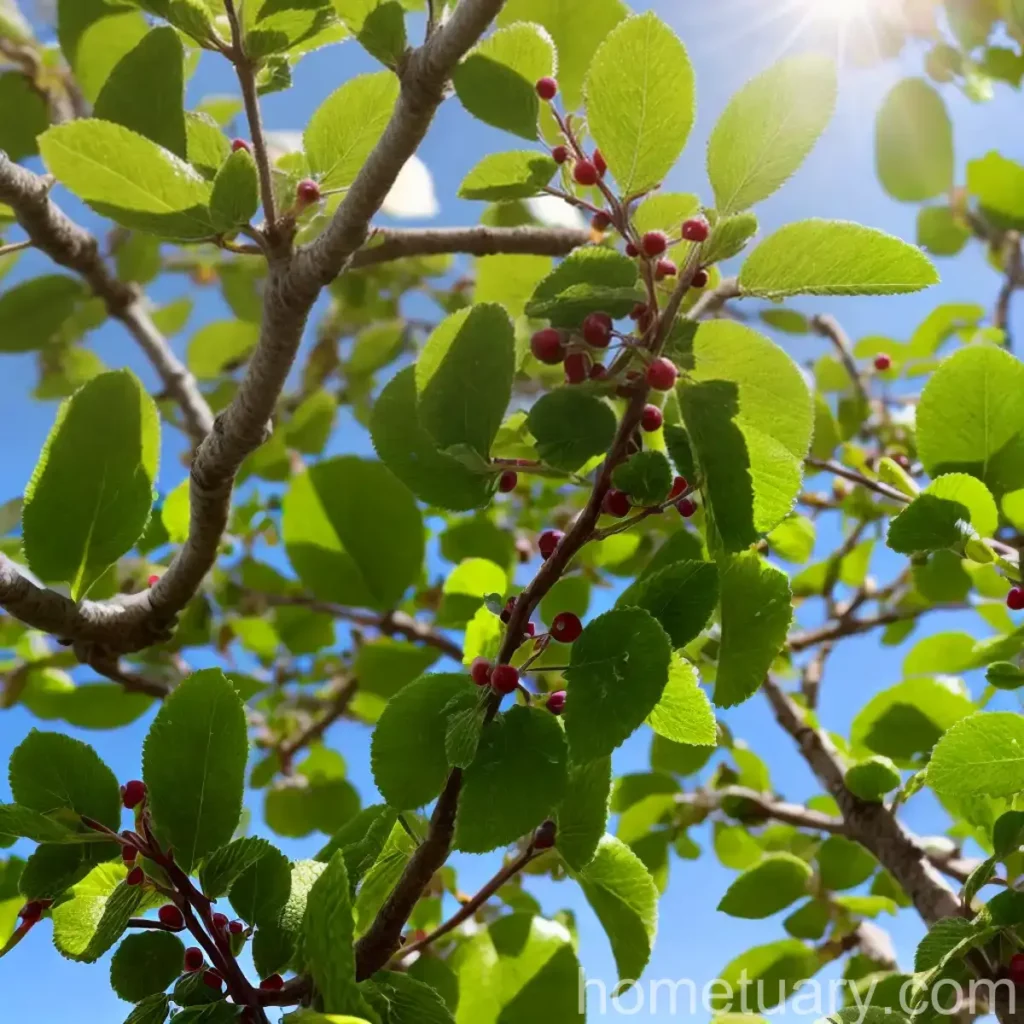Sugarberry (Celtis laevigata): A Comprehensive Guide
Welcome to this comprehensive guide on sugarberry (Celtis laevigata), a fascinating and versatile tree species. As a plant scientist, I have spent years studying and researching various plant species, and today, I am thrilled to share my expertise on sugarberry trees with you. In this guide, we will delve into the various aspects of sugarberry trees, including its culture, uses, maintenance, and much more. By the end of this comprehensive guide, you will have a thorough understanding of Celtis laevigata and how to care for it. So, let’s get started!
What is a Sugarberry Tree?
Celtis laevigata, commonly known as sugarberry, is a deciduous tree that belongs to the family Cannabaceae. It is native to the southeastern United States and is widely distributed in regions with moist soils, including bottomlands and along streams and rivers. The sugarberry tree is known for its distinctive, warty bark and its small, sweet, berry-like fruits, which are a valuable food source for wildlife.
The sugarberry tree is often confused with its close relatives, the hackberry tree (Celtis occidentalis) and the American elm (Ulmus americana) due to similarities in their leaf shapes. However, the sugarberry tree can be distinguished by its smaller, rounder fruits and its slightly smoother bark with prominent warty projections.
Key Takeaways – Sugarberry (Celtis laevigata)
Before we delve deeper into the various aspects of sugarberry trees, let’s take a quick look at the key takeaways regarding this fascinating plant species:
- Common Names: Sugarberry tree, hackberry tree, Southern hackberry, sugar hackberry, American hackberry.
- Botanical Name: Celtis laevigata.
- Characteristics: Distinctive warty bark, small sweet fruits, deciduous leaves.
- Habitat: Native to the southeastern United States, prefers moist soils along streams and rivers.
- Uses: Valuable food source for wildlife, ornamental tree in landscaping.
- Maintenance: Moderate water requirements, adaptable to a range of soil types, tolerant of urban conditions.
Now that we have an overview of sugarberry trees let’s delve deeper into its culture, uses, and maintenance.
Culture
Understanding the cultural requirements of sugarberry trees is essential for their successful growth and development. Let’s explore the key elements of the sugarberry tree’s culture, including its water and sunlight requirements, soil preferences, and more.
Water
Sugarberry trees are adaptable to different moisture conditions, making them suitable for a variety of landscapes. While they prefer moist, well-drained soils, they can tolerate periods of drought once established. Adequate water is crucial, especially during the tree’s establishment phase, but it is important to ensure that the soil is not waterlogged, as this can lead to root rot.
Here are some essential considerations regarding water for sugarberry trees:
- Establishment: Provide regular watering during the first year after planting to promote strong root development.
- Mature Trees: Once established, sugarberry trees can tolerate periods of drought, but regular watering during prolonged dry spells will promote healthier growth and fruit production.
- Watering Frequency: Water deeply and less frequently to encourage deep root growth and drought tolerance.
Sunlight
Sugarberry trees thrive in full sun to partial shade, making them versatile for various landscaping environments. When choosing a planting location for a sugarberry tree, consider the following sunlight requirements:
- Full Sun: Plant in an area that receives at least 6-8 hours of direct sunlight per day for optimal growth and fruit production.
- Partial Shade: While sugarberry trees prefer full sun, they can tolerate partial shade, particularly in regions with intense heat or dry conditions.
Soil
Understanding the soil preferences of sugarberry trees is essential for providing an optimal growing environment. Sugarberry trees are adaptable to a range of soil types, but they thrive in fertile, well-drained soils. Some key considerations for soil include:
- Texture: Sugarberry trees can tolerate a wide range of soil textures, including sandy, loamy, and clay soils, as long as they are well-drained.
- pH: They are adaptable to a broad pH range, but slightly acidic to neutral soils (pH 6.0-7.5) are ideal for optimal growth.
- Moisture: While they prefer moist soils, sugarberry trees are tolerant of periodic flooding and short-term waterlogged conditions.
Sunlight
As a plant scientist, I cannot stress enough the importance of understanding a plant’s sunlight requirements. Different plant species have varying needs when it comes to sunlight, and this principle holds true for sugarberry trees as well.
Fertilizer
When it comes to fertilizing sugarberry trees, it is essential to proceed with caution. While some trees require regular and specific fertilization schedules, sugarberry trees, including Celtis laevigata, can do well without regular fertilization. They are quite adaptable and can thrive in moderate to poor soil conditions.
Soil
As experts in plant science, we understand that a plant’s health is intricately linked to the quality of the soil in which it is planted. When it comes to sugarberry trees, soil quality plays a crucial role in determining their growth and overall health.
Pruning
Proper pruning is essential for maintaining the health, shape, and structure of sugarberry trees. Pruning should be carried out during the tree’s dormant season to minimize stress and promote vigorous regrowth.
Propagation
Propagation of sugarberry trees can be achieved through various methods, including seed propagation, hardwood cuttings, and root cuttings. Each method has its advantages and challenges, and the choice of propagation method may depend on the resources and expertise available.
Container Popularity
While sugarberry trees are commonly planted in the landscape, they can also thrive in containers, making them suitable for urban gardens, patios, and small outdoor spaces.
Container
Understanding how to care for sugarberry trees in containers is essential for maximizing their growth and health in a confined space. Here are some key considerations for container cultivation:
- Container Size: Select a large container with adequate drainage holes to accommodate the tree’s root system and promote healthy growth.
- Soil: Use a well-draining potting mix with added organic matter to provide essential nutrients and maintain moisture levels.
- Watering: Check the soil moisture regularly and water the tree when the top inch of soil feels dry to the touch.
- Fertilization: Use a balanced, slow-release fertilizer to provide essential nutrients for healthy growth.
Common Diseases
Sugarberry trees are relatively resistant to diseases and pests, but they can be affected by certain fungal infections and leaf spot diseases. Regular monitoring and proper cultural practices can help minimize the risk of disease outbreaks.
Disease Diagnosis
Diagnosing and addressing diseases in sugarberry trees is essential for preserving their health and vitality. Understanding the symptoms and causes of common diseases can aid in timely intervention and effective management.
Common Pests
While sugarberry trees are relatively resistant to pests, they can be susceptible to infestations by certain insects, including lace bugs, scale insects, and aphids. Integrated pest management practices can help mitigate pest pressure and protect the trees from serious damage.
Botanist’s Tips
As a botanist, I have had the privilege of studying and exploring the diverse world of plant species. Throughout my research and fieldwork, I have compiled a set of valuable tips for growing and caring for sugarberry trees. These tips are based on scientific knowledge and practical experience and aim to help enthusiasts and horticulturists foster healthy and vibrant sugarberry trees.
Fun Facts
Before we conclude our comprehensive guide on sugarberry trees, let’s explore some intriguing and fun facts about Celtis laevigata:
- Wildlife Value: Sugarberry trees are highly valued by wildlife for their small, sweet fruits, which serve as a vital food source for birds and small mammals.
- Historical Uses: Native American tribes used various parts of the sugarberry tree, including the wood and bark, for crafting tools, utensils, and medicinal preparations.
- Landscape Design: Sugarberry trees are prized for their ornamental value in landscaping, providing shade, visual interest, and wildlife habitat.
Links to External Resources
For further information and resources on sugarberry trees, I recommend exploring the following links:
- USDA Plants Database
- Lady Bird Johnson Wildflower Center – Native Plant Database
- Missouri Botanical Garden – Plant Finder
In conclusion, the sugarberry tree (Celtis laevigata) is a captivating and resilient tree species with a rich ecological and cultural significance. Its adaptability, wildlife value, and ornamental appeal make it a valuable addition to diverse landscapes and urban environments. By understanding the cultural requirements, uses, and maintenance practices associated with sugarberry trees, enthusiasts and horticulturists can cultivate and appreciate these remarkable trees for generations to come.
I hope this comprehensive guide has provided you with valuable insights into the fascinating world of sugarberry trees and inspired you to explore and appreciate their beauty and contributions to the natural world. Thank you for joining me on this botanical journey, and may your future encounters with sugarberry trees be filled with wonder and appreciation for their resilience and charm.















